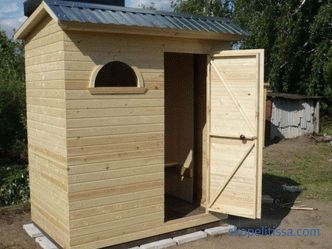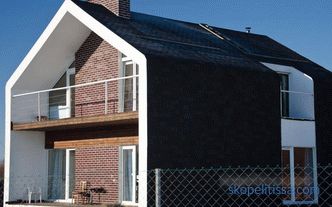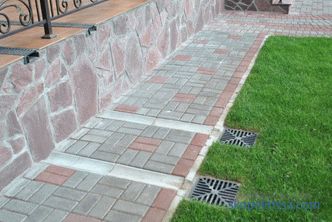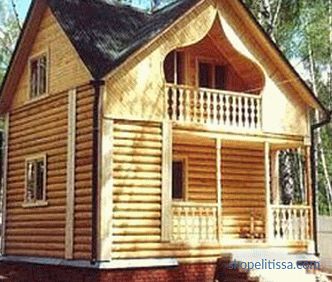Regardless of the material from which the roofing structure is constructed, its main purpose is to protect the structure from the negative impact of natural loads. The variety of roofing materials used in construction today is so huge that everyone, even the most fastidious consumer, can choose the option that suits their requirements. In this article we will talk about the self-leveling roofs, why they are so called, from what material it is constructed, the pros and cons of the structure, as well as the technology of its application.
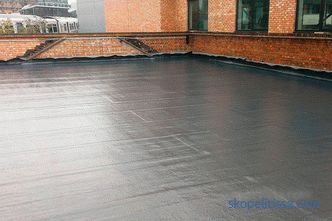
Materials for bulk roof
From the very name it becomes clear that self-leveling roof is formed by liquid or mastic materials. That is, they are simply poured onto the prepared surface and evenly distributed over it. A film is formed that closes the entire area to be processed without seams. The surface becomes one hundred percent waterproofing.
Today, manufacturers offer several materials with which they form roofs of this type.
-
Polymer-bitumen mastics and emulsions. It is mostly black mastic material, something like rubber.
-
Polyurethane polymer coating .
-
Polyurea . This roofing material is based on organics, but it has the best characteristics among all the above materials. For example, it can be applied at -40 ° C, it easily withstands severe mechanical loads, meets fire safety requirements, polymerizes within 2-3 seconds.
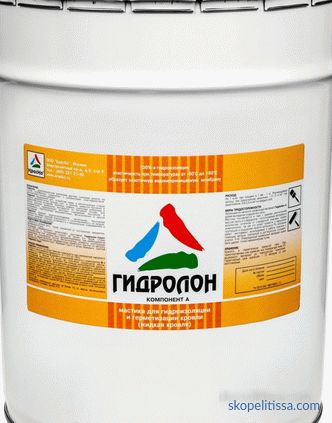
Types of bulk roofing
As for the varieties of polymeric of bulk roofing, here there are three positions:
-
reinforced ;
-
non-reinforced ;
-
combined .
The first option is a few layers of polymer mastic, between which lay fiberglass or synthetic mesh. The second option is simply applied layers of bulk material. Layers are applied in such quantity that is required by the project of construction or repair of the roof. Usually based on the quality of the processed plane. The more defects, the more layers.
The third option is a symbiosis of several building materials that are very different from each other. As one of the technologies, it is a composition of polymer mastic, rolled waterproofing material, paint, or gravel-crushed stone layer. In this case, the function of the reinforcing layer is performed by gravel or crushed stone.
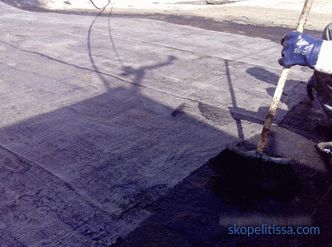
Technology of forming bulk roofing structures
Of course, the surface to be treated must first prepare. If these are standard floor slabs that are laid on the roof of a house under construction, then first of all it is necessary to take care to seal the joints between these slabs. Usually for this purpose, use the repair composition of cement and sand. If the flatness of the slab leaves much to be desired, then a thin concrete screed is poured over the slabs. She is a one-time closes and seams.
Then the surface is treated with a primer or waterproofing mastic. And after its drying go to the application of bulk material. It is simply poured over the surface of the roof and evenly distributed over the surface with a roller or spatula.
If polyurea or polyurethane material is used as a roof covering, then more often special equipment is used for the application. With the help of it, the filling paste is applied to the roof under pressure.
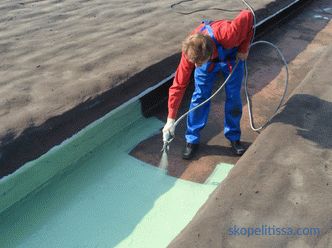
On our site you can familiarize yourself with the most popular house projects from the best construction companies with impeccable reputation in the market, including wooden logs from hand-cut logs. Directly to communicate with representatives, you can visit the exhibition of houses "Low-rise Country".
It should be noted that this roofing material, which is ultimately a thin polymer film, can be used to cover roofs that are already in use. The main task of the manufacturer of repair work is to properly carry out the whole range of work related to the repair of the roof and the application of the polymer composition.
That is, in the process of forming roofing, you can abandon the traditional technology of creating roofs, namely the use of roll roofing materials. In addition, polymer mastics are easily in contact with any materials, in the technology of their application there is no fire work and no additional adhesives.For example, in the technology of insulated flat roofs, it is possible to directly apply polymeric liquid materials on top of insulation, where foam polystyrene plates are often used. To increase the strength characteristics of a flat roof, the insulation is additionally closed with a waterproofing membrane.
That is, liquid polymer compositions can be used to cover roofs of different configurations, shapes and sizes. It does not matter from what material they are collected. All this determines the positive characteristics of this roofing.
The video shows how a self-leveling polymer roof is applied using special equipment:
On our site you can find contacts of construction companies that offer roof repair service, installation of windows and doors, house insulation. Directly to communicate with representatives, you can visit the exhibition of houses "Low-rise Country".
Advantages and disadvantages
Let's start with the advantages of a polymer roof:
-
a seamless floor forms on the roof, one hundred percent hermetic ;
-
mastic fills all defects and flaws of the work plane;
-
highest elasticity of the material , which allows to taper at low temperatures and expand at high, without breaking;
-
the minimum lifetime is 15 years, with the right approach to installation and maintenance service life is virtually unlimited;
-
bulk liquid roofs do not react to sunlight ;
-
high adhesion with any building materials;
-
high waterproofing qualities;
-
100% environmental friendliness of the material;
-
easily tolerates strong drops of humidity and temperatures ;
-
simplicity of application , you can carry out the process manually , without spending energy ;
-
not large material consumption - 1-3 kg per 1 m²;
-
mastic for a long time can be stored in an airtight container.
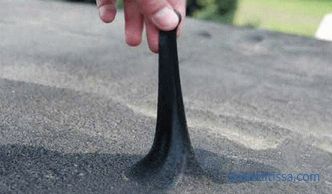
It cannot be said that this material is the owner of only positive characteristics. He has his own minuses:
-
except polyurea , other compounds can be applied to roofs at temperatures not below + 5С ;
-
polymeric mastic to be afraid of the action of solvents , which include oil products ;
-
if it is necessary to dismantle the self-leveling coating, you will have to spend a large amount of time and strength ;
-
sputtering technology requires special equipment , the cost of which affects the pricing services.
It may be interesting! In the article on the following link read about what you need to pay attention to when building a metal roofing roof according to SNiP .
Where used liquid roofs
Not long ago this technology of forming roofing coatings was used only in industrial construction. Today, restrictions have been removed, and private developers, having understood the positive aspects of the new material, immediately began to use it. More often use this technology when carrying out repair work. With the help of mastic cover flat roofs or pitched, covered with soft roofing materials (roll, shingles).
Repair of soft tile requires experience and knowledge of nuances from the manufacturer. With mastic everything is simple. Their brushes or roller applied to the surface of the tile roof, and on this we can assume that the repair is finished.
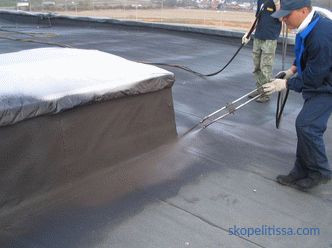
It is with polymeric mastic that repair complex roofs, as well as the junction points to the walls and chimney pipes. It is in these places that the liquid material showed itself from the best side, providing one hundred percent isolation of the plots. Mastics are used for waterproofing visors or roofs built over the balconies. In the industry, polymer mastics have found their application in sealing roofing structures of buildings and structures where it is impossible to use technologies in which open fire is used.
It is clear that the optimal use of the polymer roof is flat roofing. Here it is easier to carry out work and the material consumption is minimal. But also on the pitched roofs mastic are used. To do this, it will be necessary to carry out reinforcement so that the liquid material does not flow down the ramps, forming irregularities and smudges.
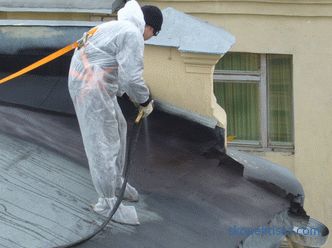
This may be interesting! In the article on the following link read about the exploited roof TechnoNIKOL - features and nodes of the system.
Conclusion on the topic
Self-leveling liquid roofs are gradually replacing roll-type constructions, even in private housing construction. Their advantages are indisputable, where it is necessary to isolate a seamless surface with serious technical and operational characteristics. The main task of the manufacturer is to strictly follow the application instructions provided by the manufacturer.
Rate this article, we tried for you

